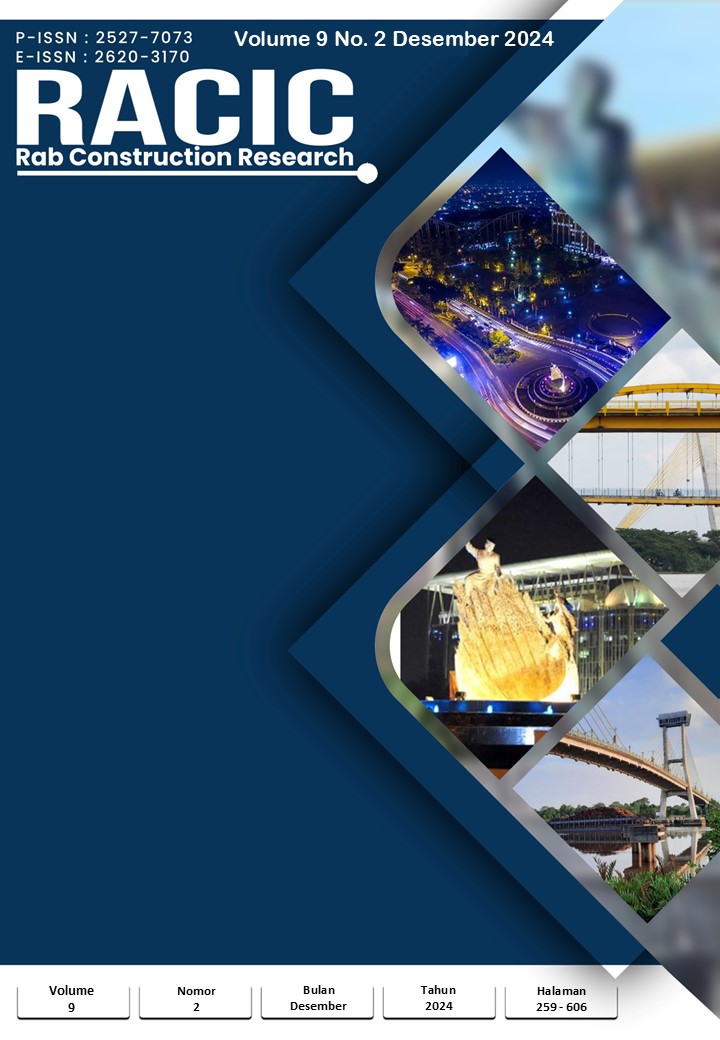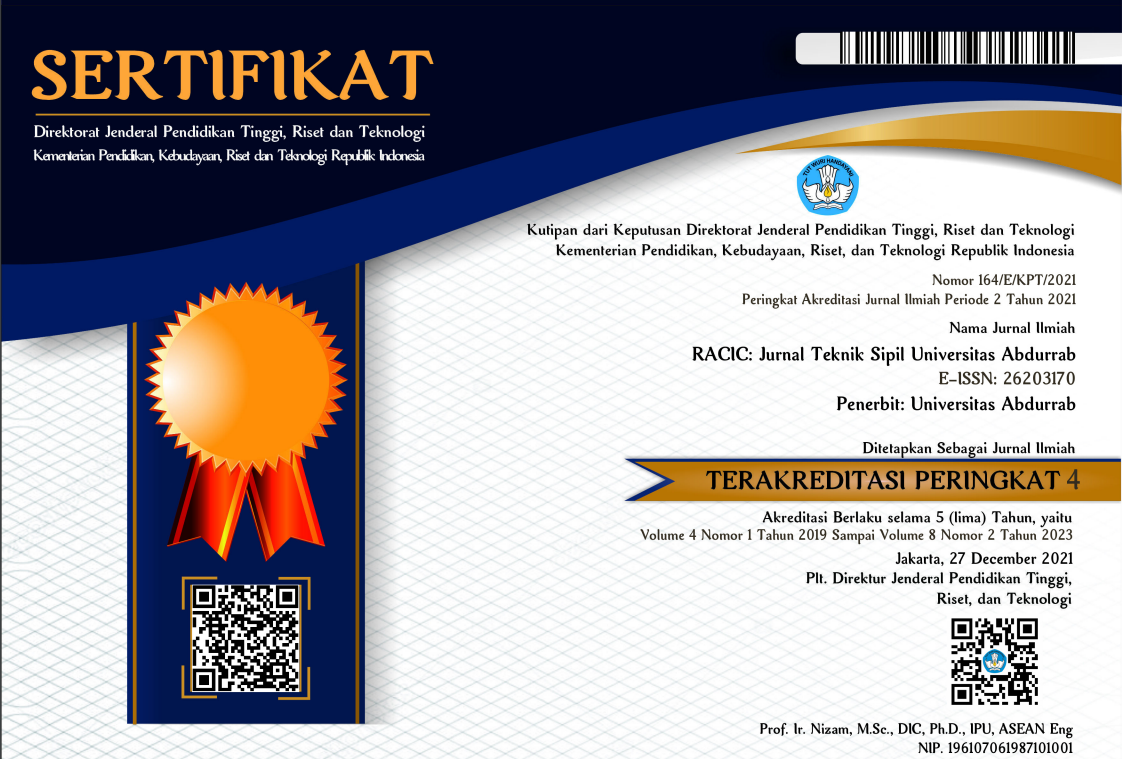ANALISIS PENURUNAN BANGUNAN REVETMENT DENGAN PERKUATAN STRUKTUR CERUCUK MATRAS BAMBU PADA TANAH LUNAK DENGAN METODE ELEMEN HINGGA DAN INSTRUMENTASI LAPANGAN
DOI:
https://doi.org/10.36341/racic.v9i2.4813Keywords:
Soft soil, bamboo pile and mattress, soil reinforcement, finite element method, instrumentation.Abstract
Soft soil is one type of soil that often causes problems if proper planning is not carried out. An alternative method to improve the bearing capacity of soft soil is by utilizing bamboo materials as piles and mattress in the foundation of a building structure. Bamboo material is chosen because of its advantages such as abundance, affordability, short harvesting period, environmental friendly, and buoyancy optimization. In this study, a comparison of settlement was conducted between finite element method and field instrumentation observations on a wharf structure along the Kapuas River in Pontianak, which utilizes bamboo mattress piles as soil reinforcement. The soil deposit at the site is predominantly soft soil up to 28 m for the thickness with shallow groundwater levels. Stability and settlement analyses were performed using finite element method utilizing Plaxis software. The construction of the revetment structure was done gradually following observations from instrumentation. In the numerical analysis, the soil layers were modeled as Mohr-Coulomb materials. Bamboo piles were modeled as elastic-plastic springs, while bamboo mattress were modeled as elastic beams. From the instrumentation observations and numerical analysis, it was found that the revetment structure with bamboo pile and mattress provided stability against sliding and failure of bearing capacity. Thus, it can be concluded that the use of bamboo as piles and mattresses for reinforcing soft soil can be carried out and provides additional support for soft soil.
Downloads
References
W. S. F. D. W. W. G. Hasibuan and W. P. Sollu, "Atlas Sebaran Tanah Lunak Indonesia," Kemenerian ESDM, Bandung, 2019.
M. A. Sattar, "Traditional Bamboo Housing in Asia: Present Status and Future Prospects," in Proceeding of the 5th International Bamboo Workshop and the 4th International Bamboo Congress, Ubud, Bali, Indonesia, 1995.
K. Ghavami, "Bamboo as reinforcement in structural concrete elements," Cement & Concrete Composites, p. 637–649, 2005.
M. Irsyam and S. Krisnanto, "Pengujian Skala Penuh dan Analisis Perkuatan Cerucuk Matras Bambu Untuk Timbunan Badan Jalan Di Atas Tanah Lunak Di Lokasi Tambak Oso, Surabaya," Forum Teknik Sipil, vol. No. XVIII, pp. 667-681, 2008.
B. M. Das, Mekanika Tanah (Prinsip-prinsip Rekayasa Geoteknis) jilid 1, Jakarta: Erlangga, 1995.
B. Widodo, P. A. Rochim, I. Masyhur and V. Widoanindyawati, "Influence of Bamboo Pile Clusters in The Pile Mattress Bamboo Construction Systems as Reinforcement of Soft Subgrade That Support Embankment Load," in IOP Conf. Series: Materials Science and Engineering, 2019.
PT Tarumanegara Bumiyasa, "Laporan Penyelidikan Tanah Pabrik PT. XYZ," Jakarta, 2014.
PT Generasi Berkat Usaha, "Gambar Desain Proyek Terminal Untuk Kepentingan Sendiri (TUKS)," 2020.
PT Teknindo Geosistem Unggul, PT Generasi Berkat Usaha, PT Rezeki Perkasa Sejahtera Lestari, "Laporan Pekerjaan Pengadaan, Pemasangan, dan Monitoring Instrumen Geoteknik Proyek Terminal Untuk Kepentingan Sendiri," Surabaya, 2021.
R. A. Hudaya and R. Swanandhia, Analisis Daya Dukung Tanah Menggunakan Matras Bambu Terhadap Beban Struktur Atas Pada Proyek Jalan Tol Semarang-Demak Seksi I, Semarang: Universitas Islam Sultan Agung, 2022.
Downloads
Published
Issue
Section
License
1. Copyright of all journal manuscripts is held by the RACIC : Rab Construction Research
2. Formal legal provisions to access digital articles of electronic journal are subject to the provision of the Creative Commons Attribution-ShareAlike license (CC BY-NC-SA), which means that RACIC : Rab Construction Research is rightful to keep, transfer media/format, manage in the form of databases, maintain, and publish articles.
3. Published manuscripts both printed and electronic are open access for educational, research, and library purposes. Additionally, the editorial board is not responsible for any violations of copyright law.
licensed under a Creative Commons Attribution-ShareAlike 4.0 International License.






